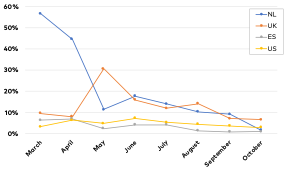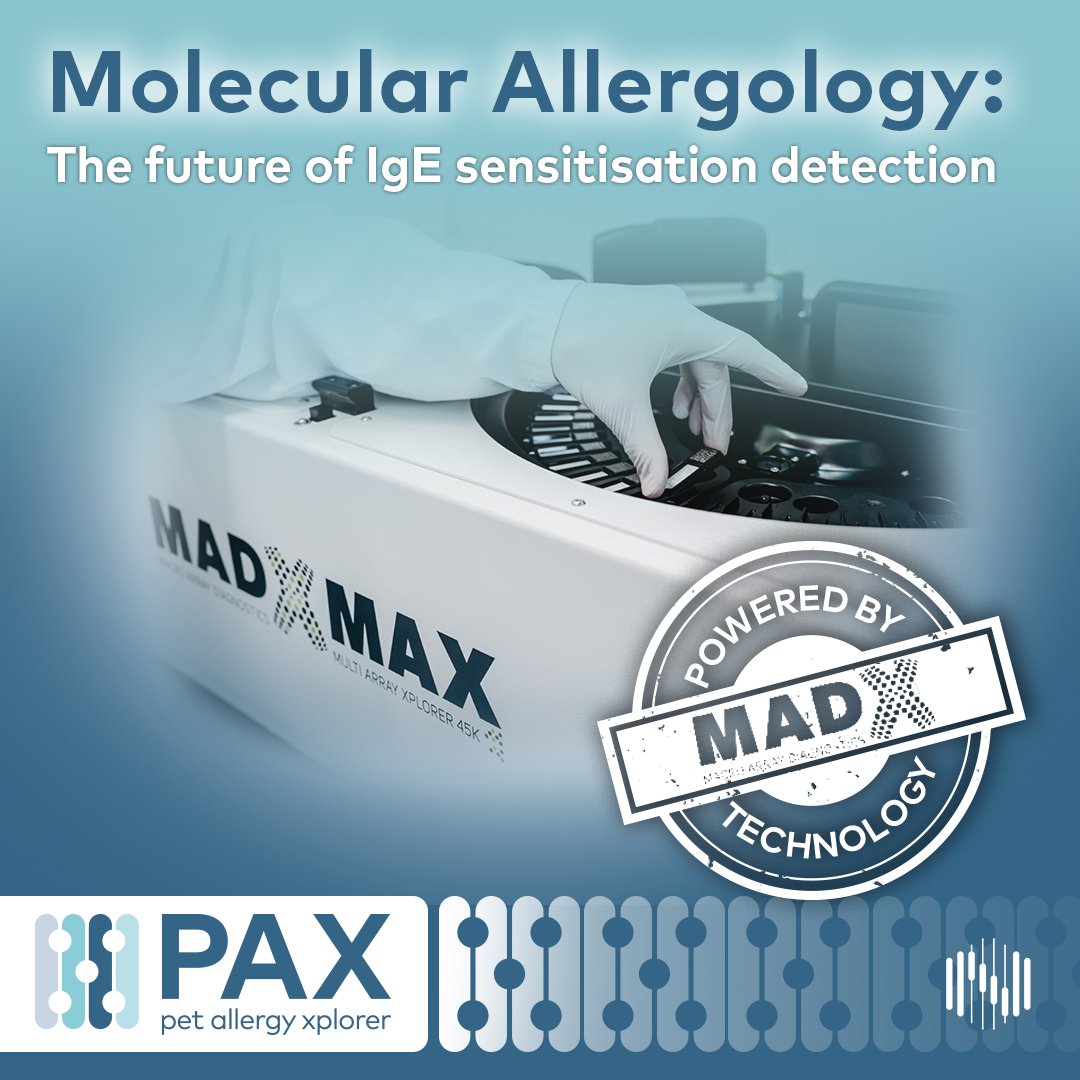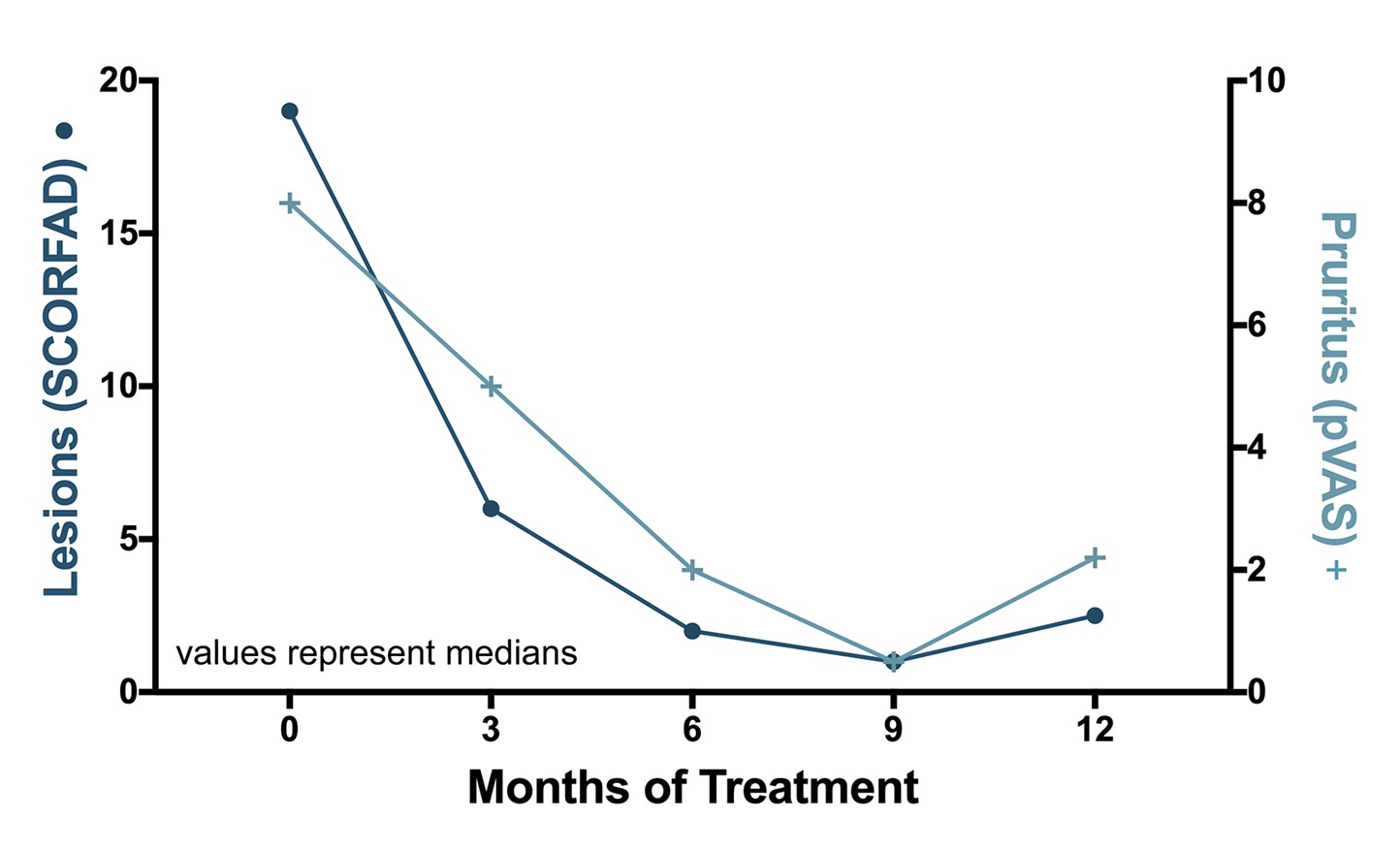A year ago, Nextmune launched the PAX, the first molecular allergology serological test for the diagnosis of allergen sensitizations in companion animals. The US was the first country to have access to the PAX for dogs in January 2023, followed by Europe in March. In September, we offered the PAX for horses and the PAX for cats was launched in January 2024.
Which are the most common sensitizations detected by the PAX?
With more than 40,000 tests results from allergy-suspected dogs (and more added every day), we have learned quite a lot in that first year. That’s the benefit of having the same platform used for dogs on multiple continents with all results downloadable from the same server.
Let’s first compare our “Top Ten” sensitizations in Europe and the US for 2023.
Europe
- Der f, Dermatophagoides farinae, house dust mite, extract
- Api m 1, Apis mellifera, honey bee venom, PLA2
- Api m, Apis mellifera, bee venom, extract
- Tyr p 2, Tyrophagus putrescentiae, storage mite, NPC2
- Ves v 1, Vespula vulgaris, wasp venom, PLA1
- Ves v 5, Vespula vulgaris, wasp venom, antigen 5
- Aca s, Acarus siro, storage mite, extract
- Api m 3, Apis mellifera, bee venom, acid phosphatase
- Ves v, Vespula vulgaris, wasp venom, extract
- Ovi a, Ovis aries, lamb meat, extract
USA
- Der f, Dermatophagoides farinae, house dust mite, extract
- Tyr p 2, Tyrophagus putrescentiae, storage mite, NPC2
- Par j, Parietaria judaica, wall pellitory, extract
- Amb a, Ambrosia artemisiifolia, ragweed, extract
- Ovi a, Ovis aries, lamb meat, extract
- Ves v 1, Vespula vulgaris, wasp venom, PLA1
- Api m 3, Apis mellifera, bee venom, acid phosphatase
- Pol d 5, Polistes dominulus, paper wasp, extract
- Api m 1, Apis mellifera, honey bee venom, PLA2
- Gly d 2, Glycyphagus domesticus, storage mite, NPC2
It is quite remarkable that thousands of kilometers apart, the most common allergen sensitizations for dogs are almost the same. They are dominated by the Dermatophagoides farinae house dust mite, the group 2 mite allergens from storage mites, and bee and wasp venom extracts and their main components.
While there is no surprise that IgE commonly targets mite allergens, it is noteworthy that the seropositivity to group 2 allergens Tyr p 2 and Gly d 2 from storage mites is about twice higher than that of the corresponding allergen from Dermatophagoides farinae Der f 2. This reflects that many dogs are sensitized to individual allergens from storage mites, from house dust mites, or from both. On an extract basis, house dust and storage mite extracts are highly cross-reactive, but this is not the case for all their allergens, especially those of the group 2. It is only with molecular allergology that one can more easily identify the primary source of allergen sensitization.
I will come back in a later blog with a detailed explanation of why dogs (actually, both normal and atopics) are sensitized to Dermatophagoides farinae house dust mites, even though this mite is absent from some geographical areas. To give a little bit away: this sensitization to D. farinae occurs because of the cross-reactivity of complex glycans on its high-molecular-weight allergens Der f 15, 18 and Zen-1 with those of mucins from the Toxocara canis nematodes. I will expand later on this unique veterinary topic.
 A surprise, seen on both sides of the Atlantic Ocean, is the very high sensitization rates to allergens from Hymenoptera insect venoms, a phenomenon not reported before in dogs. Altogether, about one of every five dogs was shown to be sensitized to bees, wasps, or both. Such a result can upset pet owners, as the fear of anaphylaxis after a sting is prevalent. However, as in humans, a positive test only signifies that the dog has been stung by bees or wasps — perhaps even only once — and that, as IgE were detected in the serum, the dog is now sensitized. We suspect that these venom-specific IgE are long-lasting in the serum of pets (in humans, they may persist for years, or even a lifetime). While some of these insect venom sensitizations are clinically relevant, others likely are not. In any case, while the bee and wasp venom extracts are cross-reactive between themselves, the PAX permits the identification of the primary sensitizing insect. For example, Api m 1 is the main bee venom allergen, while Ves v 5 is that for wasps. Our studies have confirmed that the PAX is both sensitive and very specific to detect allergies to insect venoms, so the results might be informative for some veterinarians and pet owners.
A surprise, seen on both sides of the Atlantic Ocean, is the very high sensitization rates to allergens from Hymenoptera insect venoms, a phenomenon not reported before in dogs. Altogether, about one of every five dogs was shown to be sensitized to bees, wasps, or both. Such a result can upset pet owners, as the fear of anaphylaxis after a sting is prevalent. However, as in humans, a positive test only signifies that the dog has been stung by bees or wasps — perhaps even only once — and that, as IgE were detected in the serum, the dog is now sensitized. We suspect that these venom-specific IgE are long-lasting in the serum of pets (in humans, they may persist for years, or even a lifetime). While some of these insect venom sensitizations are clinically relevant, others likely are not. In any case, while the bee and wasp venom extracts are cross-reactive between themselves, the PAX permits the identification of the primary sensitizing insect. For example, Api m 1 is the main bee venom allergen, while Ves v 5 is that for wasps. Our studies have confirmed that the PAX is both sensitive and very specific to detect allergies to insect venoms, so the results might be informative for some veterinarians and pet owners.
Timing your sampling matters
Most of us clinicians have failed to appreciate in the past that the sensitizations are not equally detectable year-round. That we should observe some fluctuation of IgE sensitizations in the body is not surprising by itself, as the half-life of IgE in the serum is about 2 days, and that on skin mast cells (in humans) about 2-3 weeks. Such a variation in pollen-specific IgE seropositivity rate depending upon the season has been only conclusively documented once in a paper from Norway (Bjelland, Acta Veterinaria Scandinavica, 2014) in which the sensitization rate to pollen allergens in the winter and spring was about 20% lower than that of the summer and fall.
The PAX, because of its use of recombinant pollen components that do not bear cross-reactive carbohydrate determinants permitted us to precisely document a seasonal variation in sensitization rates to pollen allergens.
Let’s take the example of the PR-10 family allergen Fag s 1 from Fagus sylvatica, the European (common) beech.
When we launched the PAX in March 2023 in Europe, we were surprised to see a huge difference in sensitization rates between the tests run in our PAX laboratory in the Netherlands compared to that of other countries (see figure). However, a quick search of one of the biodiversity websites (www.GBIF.org) confirmed that the beech tree was most commonly found in central-western Europe and southern Scandinavia, countries in which sera are sent to the Dutch laboratory. Beech is also found in the South of England, but rarely in Spain and the US, so the different sensitization rates to the Fag s 1 from beech could be explained by the relative prevalence of that tree in the various geographical locations.
Bottomline 1: depending upon where the pet lives, the sensitizations to pollen allergens will vary.

Bottomline 2: the sensitizations will vary depending upon the season, and a proper timing of serum sampling is essential.
At this time, to increase the chance of pollen sensitization detection in pets with seasonal signs, we recommend the following:
- Sample when the pet has active clinical signs, which ensures that the dog has been exposed to pollens triggering flares
- Sample within a couple of months after the peak of pollination for the culprit allergens, be it trees, grasses, or weeds.
Respectfully submitted,
Thierry Olivry, Head of R&D, Nextmune
 Global English
Global English

 Danmark
Danmark
 Deutschland
Deutschland
 UK
UK
 España
España
 Suomi
Suomi
 France
France
 Bélgique (FR)
Bélgique (FR)
 Italia
Italia
 Nederland
Nederland
 Norge
Norge
 Sverige
Sverige
-Dec-21-2023-09-46-12-9148-AM.jpeg)



